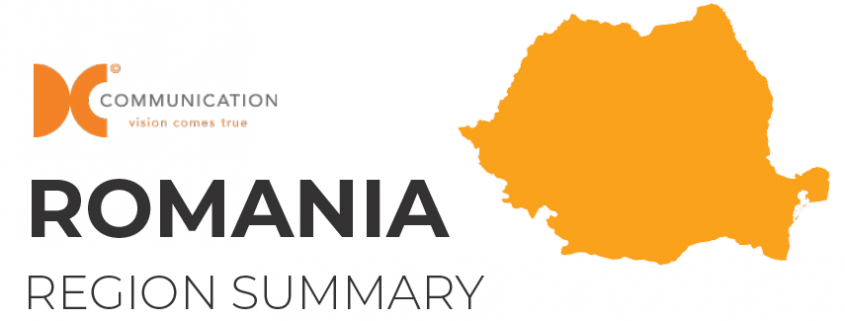Market Landscape
What are the major corporations across sectors that have decision-making units based in the region?
There are a number of multinational companies with regional centres in Romania – some are based in Bucharest, others are based in other towns. The most dynamic field is that of IT programming and, as a result, outsourcing services related to ITC.
Some of the industries and examples of companies active in Romania are:
- IT&C – Oracle, IBM, Dell EMC, Huawei, Veeam
- Gaming: Ubisoft
- Auto: Michelin
- FMCG-: Unilever, P&G
- Outsourcing: 13th world largest outsourcing hub
- Tobacco: BAT
- Consultancy: Deloitte
- Logistics: UPS, Gefco
- Military: Black Hawk (helicopters)
What are the “hottest sectors” for start-ups?
ITC is the most dynamic field but media reports suggest that the startups creation rhythm is lower locally than the European average.
What kind of sectors are the rising stars in the local economy?
ITC and the automotive sectors are the biggest employers, together with BPO companies. There are major employers in other segments such as energy and infrastructure and the scope is for the investments to become greater.
Communication Environment
What holds sway in your region – traditional or new media types and influencers? How is that changing?
The media has changed dramatically since the 2008 crisis, when the number of outlets decreased by 50% – as well as the number of journalists. Online media is more impactful in terms of circulation – either online versions of existing media or new online-only publications. As an example, the main business media magazine has up to 7,000 copies per day in print while their online version has over 178,000 unique daily visitors. General, online-only media may reach a significant number of users – e.g. 370,000 unique visitors/day.
Trade media has almost disappeared, with the existing outlets in many cases reporting only on an advertorial basis. There are some notable exceptions, such as the insurance industry, FMCG and some sections of the transportation/logistics sector.
Blogging has increased – 95,000 blogs to date – with some former journalists becoming bloggers with considerable visibility in a specific sector and with a marketing angle (this is especially the case for ITC, lifestyle, parenting). Some bloggers reach up to 50,000 unique visitors per day, making them comparable to mainstream media. However, most bloggers expect contractual relationships outside of the dedicated events to which they may come and report on.
What is the influence ecosystem – the media, analysts, consultants and non-traditional influencers (bloggers etc.). And where to start in this ecosystem?
There is no sure-fire recipe on where to start in the ecosystem – it may depend on the type of subject and the type of information available that can be transmitted. For a B2B subject, one might want to approach analysts and business specialized media, while for a B2C subject, general media and bloggers might be better suited. The launch of a product will be seen as advertising by the media, unless there is the opportunity to back it up with estimated business data, sales impact, market status, consumer behaviour, YOY comparisons or between markets, trends etc.
What kind of stories tends to dominate influencer/media attention? What type of stories receive little attention?
Firstly – the high tendency for tabloidization is clear in all segments of media and this means less attention to dry and dusty subjects, as well as increased risks if information can be presented or spun by means of a more “juicy” headline. Business media will be interested in investments, business results, innovation and trends – backed up by figures and statistics. General media will have a more utilitarian point of view and would cover the business side more lightly, although they do have economic pages. Product related info is seen as advertising, unless the product is a total novelty/ disruptive.
There is little attention, unfortunately, for CSR subjects which are often seen as a form of hidden advertising.
Communication Tools
What communication tools are the best to use in your market – media relations, social media, employer branding, events, content marketing etc.?
The only response is that it should be personalized – as there is no situation which is identical or very similar across industries or subjects. A mix of all the named tools is the best to consider, the degree of usage depending on the client’s’ objective and novelty/ business cycle.
What kind of communication software are you using in your daily activities? (media and social media monitoring, CRMs, knowledge management, project management, news distribution software etc. – give names).
We subcontract media monitoring and do our own internal content analysis, based on the monitoring results and reputation vectors. We have developed an analysis tool which uses content (not automated, but read by a human) to sort out content, share of voice per subjects, key messages, main ideas, allocation of subjects, main speakers, and more. We have also subcontracted social media monitoring.
Dashboards on channel feedback by means of questionnaires, mobile applications for events or themes. Internal questionnaires for internal communication. For impact tracking we use Klout, Similar web, Hootsuite and other tracking and content managing tools which are established as appropriate with the clients and according to their needs. We use SWOT and business analysis instruments (partners maps, impact charts), applied to communication objectives.
Examples
Do you have any “horror stories” or anecdotes that demonstrate contemporary PR/communication practice in your region?
One company wanted, according to a brief, to change the perception of an entire product range which was already seen in a sensitive way, in 2 months, with a €15,000 budget. An email request from the CEO of an organization for “one corporate communication”. No other information given and we were expected to give a price.

